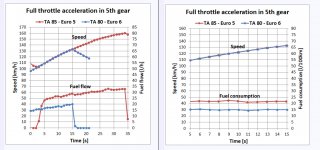Don't be another Andy, please. Are you really suggesting that my Fiat burning 10% over is going to kill the planet in a world where the 2+ tons of SUV is fast becoming the minimum? The top 2 best sellers in Oz are now 2+ ton trucks. They put out double the CO2 I do (assuming they match official) and the industry average is actually 40% over claimed...
No numbers exist for the average thermal efficiency of a diesel - no OEM that I've ever seen has put out those numbers - seriously, try to find something concrete. We do know from a few sources (notably Toyota) that 40% (yes that is 'peak') is possible from current tech petrol. We know that from simple calorific calculation that a 60mpg petrol is theoretically equivalent the same car getting 69mpg on diesel - which is about what 500 MJ's get. So the real world difference is pretty tiny- which would tend to agree with my own petrols vs diesels being hardly any different.
I think FIAT's error was loaning out press cars that weren't run in. ~38MPG they all cried - that was all the ammo the experts needed - any claims of good mpg are now simply ignored. I got ~38MPG driving (new car/ new engine) gently on my first tank too.
I own 2, 4, 6, and 8 cylinder engines, petrol, diesel and hybrid. So I don't think I have a 'chosen' engine, frankly they all have their charms
UFI's even going up for sale soon (I no longer need a small car), I want an Exige, which will be my first V6 (I hate V6's).



